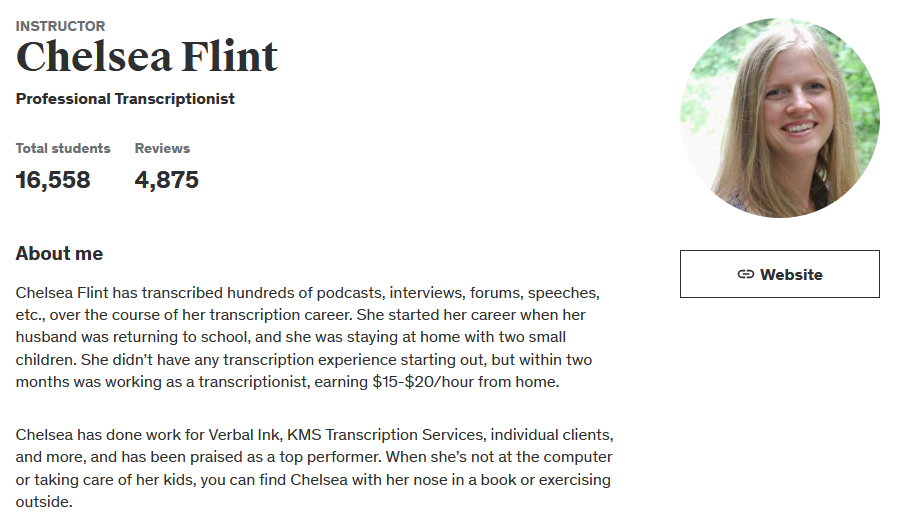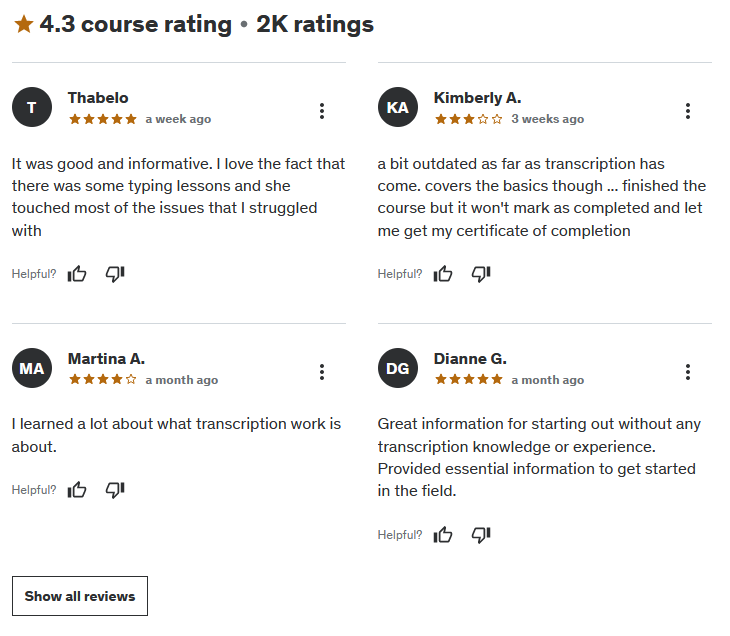Hey there! If you’ve been on the hunt for a genuine, no-frills guide to kickstarting your transcription career from the comfort of your home, you might just be in luck. I recently wrapped up the “How to Become a Transcriptionist” course on Udemy, and I’ve got some thoughts to share. Spoiler alert: it’s pretty much a goldmine for beginners.
First off, this course is all about transforming you into a transcription pro, ready to tackle audio files and create those crisp, clean transcripts. It’s designed for folks who are eyeing a work-from-home setup, promising the sweet spot of earning $15-$25 an hour with part-time effort. And let me tell you, it delivers on that promise.
Instructor Reputation: Chelsea Flint – An In-Depth Look
When diving into a new field or skill, the instructor’s background and approach can make or break your learning experience. In the case of the “How to Become a Transcriptionist” course on Udemy, Chelsea Flint stands as a beacon for aspiring transcriptionists. With an impressive instructor rating of 4.4, backed by nearly 5,000 reviews, and over 16,000 students under her guidance, Chelsea’s credentials are not just numbers; they narrate a story of dedication, growth, and passion.

Chelsea embarked on her transcription journey out of necessity, seeking a flexible work-from-home opportunity while her husband returned to school and she cared for their two young children. This relatable start to her career resonates with many looking to transcription as a viable, flexible work option. What makes her stand out is not just her ascent from a novice to a professional transcriptionist, earning $15-$20 per hour, but also her commitment to sharing this pathway with others.
Her work experience spans across reputable transcription companies like Verbal Ink and KMS Transcription Services, in addition to handling individual clients. This exposure to a broad spectrum of transcription work, from podcasts and interviews to forums and speeches, has equipped Chelsea with a deep understanding of the industry’s demands and nuances. Her students often laud her for being a top performer, not just in transcription but in teaching the craft. Beyond her professional accolades, Chelsea’s personal touch—balancing work, family life, and personal interests like reading and outdoor activities—adds a layer of relatability and inspiration to her teaching.
In her course, Chelsea doesn’t just lecture; she mentors. She offers a blend of practical advice, industry insights, and personal anecdotes that make the learning process engaging and relatable. Her approachable style and comprehensive coverage of both the technical and soft skills needed in transcription work have garnered positive feedback from students, highlighting her ability to demystify the field and empower beginners.
Course Structure: A Comprehensive Breakdown
The “How to Become a Transcriptionist” course is meticulously structured to cater to both absolute beginners and those with some background in secretarial or editing roles. With 22 screencast video lessons, Chelsea Flint takes students on a detailed journey through the transcription industry, starting from the absolute basics to the intricacies of working as a subcontractor for transcription companies.

The course kicks off with an introduction to the transcription industry, laying a solid foundation for understanding the work and its demands. Chelsea emphasizes the importance of starting with minimal investment in equipment, showcasing that a simple pair of $10 earbuds and the free version of Express Scribe are enough to get your feet wet. This practical approach to gear and software makes the entry barrier feel incredibly low.
As the course progresses, students delve into the technical skills needed for transcription work. This includes using Express Scribe to download, play, and transcribe audio, as well as mastering Microsoft Word’s AutoCorrect feature to create text expanders, a critical skill for boosting efficiency. Chelsea also covers working with style guides, a vital aspect of producing professional-quality transcripts that meet client specifications.
One of the course’s strengths is its focus on creating a transcription-specific cover letter and resume. Recognizing that many aspiring transcriptionists may not have direct experience in the field, Chelsea provides guidance on leveraging related skills and experiences to create compelling job applications. This section is incredibly valuable for beginners, offering a blueprint for breaking into the industry.
The application process to transcription companies is demystified through detailed tutorials that cover best practices for resume creation and job application strategies. Chelsea goes a step further by addressing the business side of transcription work, including managing subcontractor relationships and strategies for increasing income as one gains more experience.
Practical, hands-on experience is a cornerstone of the course. Students are given three practice audio files to transcribe, accompanied by answers for self-assessment. This hands-on practice is crucial for building confidence and competence before applying to transcription companies.
Lastly, the course doesn’t stop at landing your first job. Chelsea provides strategies for career growth and income increase, ensuring that students are equipped not just to start their transcription careers but to thrive in them.
In summary, the course’s structure is designed not just to impart knowledge but to build skills, confidence, and a pathway to success in the transcription industry. It’s a comprehensive, step-by-step guide that covers every aspect of becoming a successful transcriptionist, making it a valuable resource for anyone looking to enter this field.
Content Quality: A Closer Examination
The “How to Become a Transcriptionist” course, led by Chelsea Flint, stands out for its high-quality content that spans the breadth and depth of transcription work. This course is tailored to offer a comprehensive understanding, equipping students with not only the technical skills required for transcription but also the insights into industry practices, tools, and career development strategies.

Depth of Material
One of the course’s strong suits is its detailed exploration of the transcription industry. Chelsea does an excellent job of breaking down the types of transcription work available, the expectations of transcription companies, and the nuances of working as a subcontractor. This foundational knowledge is crucial for newcomers who are often unaware of the breadth of opportunities and challenges in transcription work.
Technical Skills and Tools
The course excels in teaching the practical skills necessary for transcription. It covers the use of Express Scribe, a popular transcription software, in detail, showing students how to download, play, and transcribe audio effectively. The lessons on Microsoft Word’s AutoCorrect feature for creating text expanders are particularly valuable, offering tips that can significantly boost transcription speed and efficiency.
Moreover, the course delves into the specifics of setting up a professional transcription environment on a budget, showcasing that entry into this field doesn’t require a hefty upfront investment. This pragmatic approach to tools and software makes the course accessible to a wider audience.
Real-World Application
Chelsea Flint’s emphasis on creating a transcription-specific resume and cover letter is a highlight. For many students, this section will be their first foray into professional transcription job applications. The detailed guidance, paired with resume examples, provides a solid foundation for those uncertain about how to present their skills to potential employers.
The inclusion of practice audio files for transcription is another strong point, offering students hands-on experience. However, some feedback suggests a desire for more variety in these practice files, such as different accents or speaking styles, to better prepare students for the diversity of real-world transcription work.
Engagement and Learning Support
Throughout the course, Chelsea’s teaching style is engaging and supportive. Her lessons are peppered with personal anecdotes and insights from her own career, making the material relatable and encouraging for students. Additionally, the course’s structure allows students to progress at their own pace, which is beneficial for learners balancing other commitments.
Overall Course Rating: 9/10
Taking into account the comprehensive curriculum, the practical skills taught, the instructor’s expertise, and student feedback, I rate “How to Become a Transcriptionist” course a solid 9 out of 10.

This course is an exceptional resource for anyone looking to enter the transcription field. The content quality is high, covering essential tools, techniques, and industry insights that are crucial for beginners. Chelsea Flint’s engaging teaching style and the inclusion of real-world application exercises enhance the learning experience significantly. However, the course could be improved with the addition of more diverse practice materials, as mentioned in some student reviews. This would prepare students for a wider range of transcription scenarios, making them more adaptable in their future careers.
It successfully bridges the gap between novice and professional, offering a clear, accessible path into the transcription industry. The course stands out for its detailed approach to skill-building, practical insights into the transcription profession, and the supportive learning environment fostered by Chelsea Flint.
In summary, “How to Become a Transcriptionist” is a well-rounded and effective course for those serious about starting a transcription career. It balances technical skills, industry knowledge, and career preparation in a way that is both informative and inspiring. For anyone looking to work from home as a transcriptionist, this course provides the tools, knowledge, and confidence to make that goal a reality.



